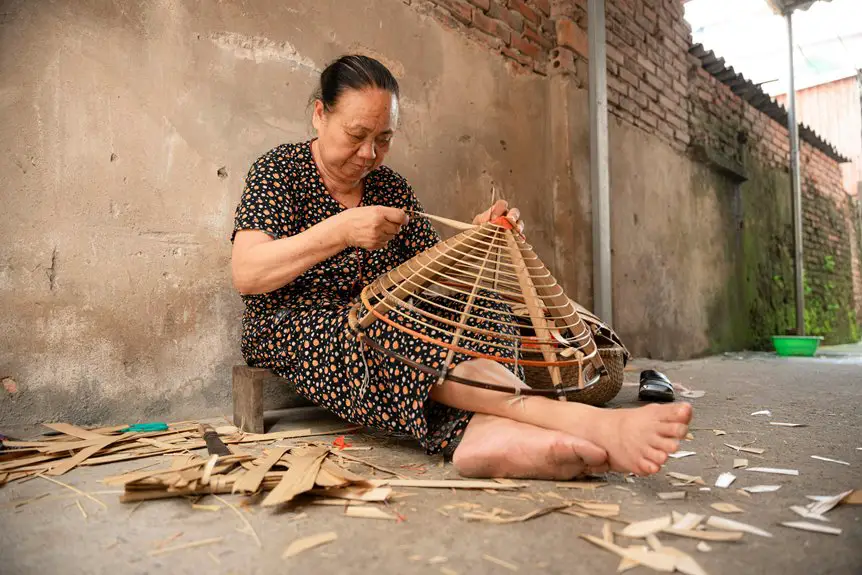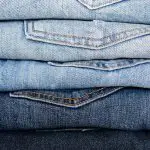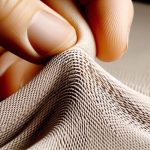Imagine a clothing brand that markets its bamboo viscose garments as eco-friendly, only to later reveal questionable sourcing practices. This scenario raises important questions about the sustainability of bamboo viscose. What looks green on the surface can often conceal a more complex reality beneath. Understanding the intricacies of bamboo production and its impact on the environment is essential for making informed choices. Are you ready to uncover the truth?
Table of Contents
Key Takeaways
- Bamboo grows rapidly and requires minimal water, making it a potentially sustainable raw material for textiles if sourced responsibly.
- The production of bamboo viscose often involves harmful chemicals, raising concerns about environmental and worker safety.
- Large-scale bamboo farming may lead to monoculture practices, negatively impacting biodiversity and local ecosystems.
- Certifications like GOTS and OEKO-TEX help ensure bamboo products are sustainably sourced and free from harmful substances.
- Supporting brands that prioritize eco-friendly practices and transparent supply chains can enhance the sustainability of bamboo viscose products.
The Benefits of Bamboo as a Raw Material
Bamboo offers a range of benefits as a raw material that make it an exceptional choice for sustainable products.
First, it grows rapidly, reaching maturity in just three to five years, which means you can rely on a consistent supply without depleting resources. Its natural strength and durability provide long-lasting products, reducing waste over time.
Furthermore, bamboo requires minimal water and no pesticides to thrive, making it an environmentally friendly option. When you choose bamboo, you’re also supporting carbon sequestration, as it absorbs more CO2 than many trees.
Bamboo thrives with minimal water and no pesticides, making it a highly sustainable choice that actively supports carbon sequestration.
Additionally, its ability to regenerate without replanting preserves soil quality. By opting for bamboo-based products, you’re making an eco-conscious decision that benefits both you and the planet.
Challenges in Bamboo Viscose Production
While bamboo is celebrated for its sustainability, the production of bamboo viscose faces several challenges that can undermine its eco-friendly reputation.
One major issue is the chemical process used to convert bamboo into viscose, which often involves harmful solvents like sodium hydroxide and carbon disulfide. These chemicals can pose risks to both the environment and workers’ health if not managed properly.
Additionally, the large-scale farming of bamboo can lead to monoculture practices, reducing biodiversity and depleting soil nutrients. You might also find that many bamboo products aren’t sourced sustainably, contributing to deforestation and habitat loss.
Consequently, while bamboo itself is a sustainable material, the processes involved in making bamboo viscose can be quite problematic.
Comparing Sustainability: Bamboo vs. Other Fibers
When you compare bamboo to other fibers, you’ll notice significant differences in water usage, chemical processing, and regrowth rates.
Bamboo typically requires less water and fewer chemicals, making it an eco-friendlier choice.
Understanding these factors can help you make more sustainable decisions in your textile choices.
Water Usage Comparison
Although many fibers require significant water for production, bamboo stands out for its lower water usage, making it a more sustainable choice for environmentally conscious consumers.
When you compare bamboo to other fibers, you’ll notice that:
- Bamboo plants thrive on rainfall, needing minimal irrigation.
- It absorbs up to 30% more water from the soil than cotton.
- Bamboo’s rapid growth means it can be harvested more frequently, reducing overall water demand.
- It flourishes in diverse climates, requiring less water management.
- The production process uses less water compared to conventional cotton and polyester.
Choosing bamboo not only supports a more sustainable textile industry but also helps conserve precious water resources.
Your choices can have a significant impact on the environment!
Chemical Processing Intensity
Chemical processing intensity greatly impacts the sustainability of textile fibers, and bamboo offers a more eco-friendly alternative compared to many conventional materials. While cotton and synthetic fibers often require extensive treatments and chemicals, bamboo’s processing can be less intensive. Here’s a quick comparison:
| Fiber Type | Chemical Processing Intensity |
|---|---|
| Bamboo | Moderate |
| Cotton | High |
| Polyester | Very High |
| Hemp | Low |
| Linen | Moderate |
Bamboo fiber can be produced using a closed-loop system, which recycles water and chemicals, minimizing harmful waste. In contrast, conventional fibers often leave a significant environmental footprint. By choosing bamboo, you’re opting for a textile that aligns better with sustainable practices.
Regrowth Rates Analysis
Regrowth rates play an essential role in evaluating the sustainability of textile fibers, and bamboo stands out for its rapid growth compared to other materials.
In just a few months, bamboo can reach impressive heights, making it a strong contender in the sustainable fiber arena.
Here’s how bamboo’s regrowth rates compare to others:
- Bamboo: Up to 3 feet in 24 hours.
- Cotton: Takes several months to grow and requires significant water.
- Wool: Depends on sheep’s annual growth cycle.
- Hemp: Regrows in about 3 to 4 months but isn’t as fast as bamboo.
- Polyester: Not a natural fiber, hence doesn’t regrow at all.
This rapid regrowth not only supports a sustainable cycle but also minimizes the environmental impact of harvesting.
Impact on Biodiversity and Ecosystems
When considering bamboo viscose, you need to think about its impact on biodiversity and ecosystems.
While bamboo can support habitats, the methods used for processing it may lead to soil contamination risks.
It’s crucial to weigh these factors carefully as you explore sustainable choices.
Soil Contamination Risks
While bamboo is often praised for its eco-friendly attributes, the cultivation process can pose significant soil contamination risks that threaten biodiversity and ecosystems.
When you consider how bamboo is grown, it’s essential to recognize the potential impacts:
- Pesticides leaching into the soil, harming beneficial organisms
- Excessive fertilizers creating nutrient imbalances
- Soil erosion leading to loss of habitat for native species
- Chemicals disrupting microbial communities important for soil health
- Runoff contaminating nearby water sources, affecting aquatic life
These factors can create a ripple effect, diminishing the natural balance necessary for diverse ecosystems.
As bamboo’s popularity grows, it’s imperative to question whether its cultivation truly aligns with sustainable practices or inadvertently contributes to environmental degradation.
Habitat Support Mechanisms
Although bamboo cultivation can pose risks to soil health, it also offers unique habitat support mechanisms that can enhance biodiversity and ecosystems.
When you grow bamboo, its dense root systems stabilize soil, preventing erosion and promoting water retention. This creates a healthier environment for various plant and animal species.
Additionally, bamboo forests provide shelter and food for wildlife, fostering rich ecosystems. You’ll find that these areas often attract a variety of birds, insects, and small mammals, contributing to ecological balance.
Moreover, bamboo’s rapid growth means it can sequester carbon efficiently, helping mitigate climate change effects.
Consumer Awareness and Choices
How can you make informed choices about the fabrics you wear? Understanding fabric origins and production methods is key.
Making informed choices about fabrics involves understanding their origins and production methods.
When selecting bamboo viscose, consider these factors:
- Certifications: Look for eco-labels that indicate sustainable practices.
- Transparency: Choose brands that openly share their sourcing and manufacturing processes.
- Environmental Impact: Research the water usage and chemical treatments involved in production.
- Durability: Opt for high-quality fabrics that last longer and reduce waste.
- End-of-Life: Think about how the fabric can be disposed of or recycled.
Innovations in Sustainable Bamboo Production
As the demand for sustainable textiles grows, innovations in bamboo production are transforming the industry. Farmers are now adopting eco-friendly practices, such as using natural pest control and organic fertilizers, which enhance sustainability. Additionally, advanced processing techniques minimize waste and energy consumption, making bamboo a more viable option for conscious consumers like you.
Here’s a quick look at some key innovations:
| Innovation | Description | Benefits |
|---|---|---|
| Eco-Friendly Farming | Organic fertilizers and pest control | Reduces chemical use |
| Closed-Loop Systems | Recycling water and chemicals | Lowers environmental impact |
| Energy-Efficient Tech | Improved processing methods | Decreases energy consumption |
These innovations aren’t just beneficial; they’re essential for the future of sustainable bamboo production.
The Role of Certifications in Sustainable Practices
Certifications play an essential role in promoting sustainable practices within the bamboo industry. They guarantee consumers that the products they’re buying are eco-friendly and responsibly sourced.
When you choose certified bamboo viscose, you’re supporting a supply chain that prioritizes environmental health and social responsibility.
Here are some key certifications to look for:
- FSC (Forest Stewardship Council): Guarantees responsible forest management.
- OEKO-TEX Standard 100: Ensures that textiles are free from harmful substances.
- Global Organic Textile Standard (GOTS): Certifies organic status and ethical practices.
- Rainforest Alliance: Promotes biodiversity and sustainable livelihoods.
- Cradle to Cradle: Focuses on sustainable product design and circular economy principles.
Future Directions for Bamboo Viscose Sustainability
While the bamboo viscose industry has made strides in sustainability, ongoing innovation and commitment are vital for its future. You can play an important role by supporting companies that invest in eco-friendly production methods.
Look for brands that prioritize closed-loop processing, reducing waste and chemical usage. Encouraging research into alternative solvents and more efficient harvesting techniques can also drive progress.
Additionally, advocating for transparency in supply chains helps guarantee ethical practices. You might consider choosing products with certifications that verify sustainability claims.
Engaging with local communities to promote responsible bamboo farming can enhance biodiversity and support livelihoods. Together, these actions can lead to a more sustainable bamboo viscose industry that balances environmental responsibility with consumer demand.
Frequently Asked Questions
Can Bamboo Viscose Be Recycled After Its Lifecycle?
Only about 30% of textiles are recycled globally. Unfortunately, bamboo viscose isn’t easily recyclable due to its chemical processing. Instead, consider repurposing it creatively or opting for sustainable alternatives to reduce waste.
What Are the Health Impacts of Wearing Bamboo Viscose Clothing?
Wearing bamboo viscose clothing generally feels soft and breathable, which can be comfortable for your skin. However, some people might experience irritation or allergies due to chemicals used in its production, so it’s important to choose wisely.
How Does Bamboo Viscose Compare to Synthetic Fibers?
Bamboo viscose feels softer and breathes better than most synthetic fibers, offering comfort and moisture-wicking properties. However, its production can be less environmentally friendly, unlike some recycled synthetics that minimize waste and resource use.
Is Bamboo Viscose Biodegradable or Compostable?
Imagine tossing your fabric scraps into a garden, watching them disappear. Bamboo viscose isn’t truly biodegradable; it breaks down slowly in landfills. While it’s more eco-friendly than synthetics, it still has limitations.
Are There Any Ethical Concerns Regarding Bamboo Harvesting Practices?
When you consider bamboo harvesting, ethical concerns arise. Some practices can lead to deforestation and habitat loss, while labor conditions may not always be fair. It’s crucial to research brands that prioritize sustainable and ethical sourcing.
- How Dyes Are Used to Increase Contrast in Microscopy - July 13, 2025
- The Role of Coomassie Blue Dye in SDS-PAGE Technique - July 13, 2025
- Which Dye Is Used in the Acid-Fast Staining Technique? - July 13, 2025







